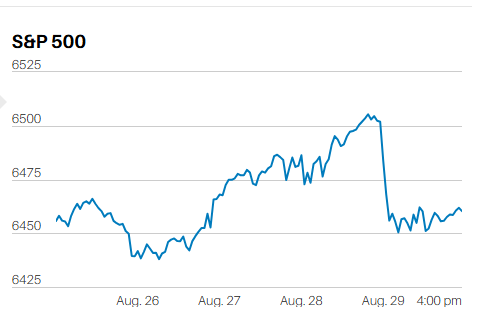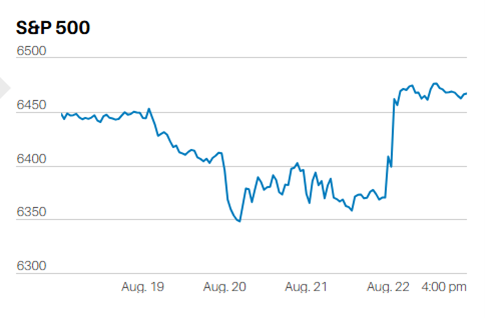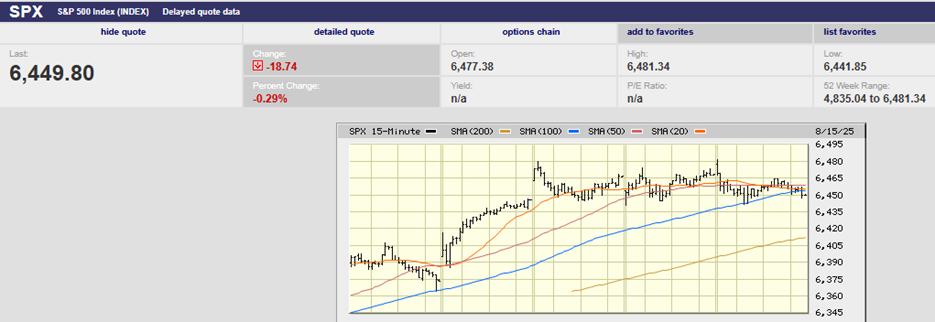Increase returns without increasing risk by diversifying

Market Update:
The S&P 500 lost 5.7% last week to close at 4397.94. The index closed below its 200-day moving average. We wrote last week that the S&P 500 could test its 200-day in the next few weeks. We didn’t think it would happen in the next four trading days. The 200-day is the main trend, and the trend is still rising. Markets don’t usually put in V tops. Instead, the topping process is normally months in the making. In other words, it is unlikely that we are heading straight into a 20% plus decline. The S&P 500 is oversold with a Relative Strength Index (RSI) under 20. Odds favor a bounce in the coming week, although a down opening on Monday is a possibility. Instead, we should see months of sideways trading before any major decline commences. It doesn’t always work that way though. And of course, investors shouldn't make investment decisions based on guessing market direction.
As always it is a market of stocks rather than a stock market. Different indexes, sectors, and industries are performing differently. The Dow Jones Industrial Average is down 5.7% year-to-date (YTD). The S&P 500 has fallen 7.7% in 2022. The Nasdaq has dropped 12% and is on pace for its worst January on record, according to Barron’s. We’ve written often over the last six months of the rising risk in growth stocks. Price is paramount and technology stocks were (and still are) trading way above normal valuation levels.
Pundits are pointing to rising interest rates as the catalyst for the weakness in growth stocks. The 10-year Treasury note’s yield is up 26 basis points since the start of the year. It finished the week at 1.76%. The federal-funds futures market has priced in a 0.25% rate hike in March, according to CME FedWatch. Some analysts believe the Fed may wind down its bond-buying in February rather than March, according to Barron’s. Those same analysts believe the Fed may start to shrink its balance sheet as early as March as well. All else equal, mortgage rates will rise as the Fed stops buying mortgage-backed bonds. Rising mortgage rates should slow the housing market.
Volatility is the watchword for 2022. Norwood Economics is expecting a flat stock market this year. Value stocks should outperform growth. Technology stocks especially are likely to disappoint investors after years of outstanding returns.
Economic Indicators:
The Empire State manufacturing index fell 0.7 percent in January from 31.9 the prior month. It is the first negative reading in 20 months. Any reading below zero indicates worsening conditions. The index of new orders sank 32 points causing much of the overall decline, according to MarketWatch. Businesses saw little relief from inflation with prices paid and prices received falling only slightly. The Omnicron variant is thought to be the main cause. Yet, the Philadelphia Fed manufacturing survey rose to 23.2 in January from 15.2. Perhaps there are other factors that impacted the Empire State manufacturing index besides Covid.
Building permits rose to 1.87 million in December from 1.72 million the month prior. Building permits are a leading indicator for the housing market. Housing starts rose to 1.70 million from 1.68 million. Rising mortgage rates may slow the housing market by the spring. Existing home sales dropped to 6.18 million in December from 6.48 million the prior month. The 10-year Treasury is most closely tied to the 30-year fixed mortgage rate. Many economists are expecting the 10-year to continue to rise. Some economists think it could reach 2.50% in the next few quarters. Norwood Economics believes that any move into the mid-two percent range will be short-lived. The economy can’t long survive higher interest rates with 29 trillion in debt weighing it down.
Initial jobless claims rose to 286,000 from 231,000 last week. Jobless claims have risen the last few weeks. Omnicron is again the most likely explanation. Jobs are a lagging indicator. Meanwhile, the Leading Economic Indicator (LEI) rose 0.8% in December from 0.7% the prior month. The LEI is a weighted gauge of 10 indicators intended to predict future economic activity. The current conditions indicator rose 0.2% in December up from the prior month. The lagging index rose 0.1%. The first quarter is expected to be weaker than Q4 of 2021. Omnicron, labor shortages, and inflation are all factors, according to Ataman Ozyildirim of the Conference Board. The Conference Board is forecasting 3.5% economic growth for all 2022. Norwood Economics believes growth will be less than 3% this year and could be as low as 2.0%. The debt load will slow the economy faster than generally thought.
Perceived risk and real risk:
I had a 401(k) participant reach out to ask about her 401(k) account. We’ll call her Mary. Mary wanted to move to a more conservative portfolio. Norwood Economics works with more than twenty 401(k) plans and Cash Balance plans. We recommend low-cost target-date funds and individual index funds for 401(k) investment fund lineups. We include pre-built portfolios so that individuals don’t have to create their own. The idea is that we’re better at building diversified portfolios than most 401(k) plan participants. The five pre-built portfolios are income, balanced, growth & income, growth, and aggressive growth. Mary was in the income portfolio, which is designed for people already in retirement. She is 53 years old and plans on working for at least another 12 years.
I let her know that she was already in the most conservative pre-built portfolio. I asked her why she felt the need for something more conservative. Mary’s specific concern was her exposure to international and emerging market index funds. She feels investing in non-U.S. stocks is too risky. Mary is wrong to shy away from international and emerging market stocks. Diversification is the only free lunch in investing. The data shows that an investor can increase returns without increasing risk by diversifying. Higher return with the same amount of risk is desirable. The same return with lower risk is also desirable. Diversification allows either depending on the investor’s preference. Mary's portfolio is less risky by including international and emerging market stocks.
Mary is also wrong about international and emerging markets being higher risk, at least for the next five-plus years. Institutional investors define risk as volatility. The S&P 500 has a standard deviation of around 17%. The FTSE developed markets index also has a standard deviation of around 17%. The FTSE emerging markets index has a standard deviation of around 18.5%. The emerging-market index is only a bit more volatile than both the S&P 500 and developed markets index.
Standard deviation isn’t the whole story on risk in 2022, however. The S&P 500 is one of the most expensive stock markets in the world right now. And that makes it riskier than either developed or emerging markets. The S&P cyclically adjusted price-to-earnings (CAPE) ratio is approximately 37. It has never been higher except in 1999 during the dotcom bubble when CAPE hit 44. The international stock market CAPE is 20. Emerging market stocks haven’t gone anywhere in over a decade. The main China index was down 30% in 2021. Emerging markets including China are cheap. Most Wall Street strategists expect international and emerging markets to outperform the U.S. stock market over the next five to ten years. Why? Because they are cheap. Price determines return. Cheap assets outperform expensive ones over longer periods of time.
Everyone should have a diversified portfolio. Everyone should have exposure to international and emerging markets. Norwood Economics is overweight international and especially emerging markets.
Regards,
Christopher R Norwood, CFA
Chief Market Strategist











